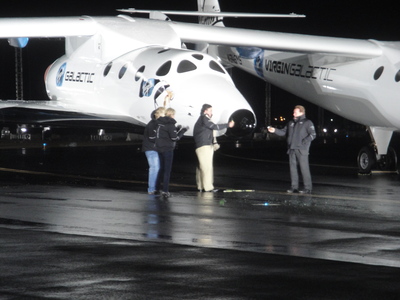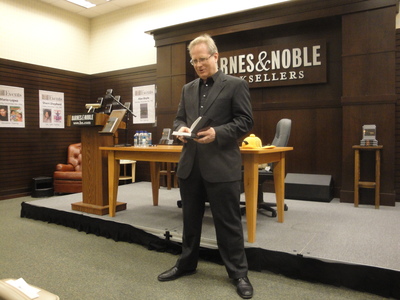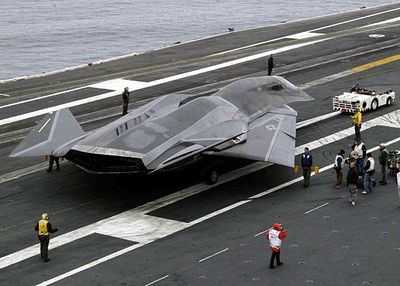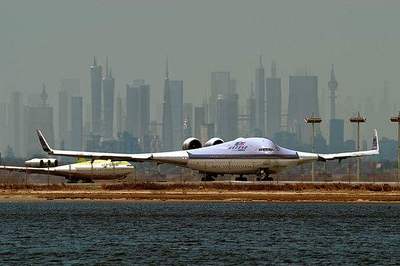We are developing the social individualist meta-context for the future. From the very serious to the extremely frivolous... lets see what is on the mind of the Samizdata people.
Samizdata, derived from Samizdat /n. - a system of clandestine publication of banned literature in the USSR [Russ.,= self-publishing house]
|
The world’s first commercial spaceship was unveiled and christened today at Mojave. I will post more when I have slept and caught my flight home, but here is just one photo of the very full day of activities. I did not have as much time as Rand Simberg to get articles out due the large number of hats I was wearing today. I was also not official press although I could have slipped in as most of the annointed press knew me and would have said nothing
In any case, I will have more to say and I have hundreds of photos. Here is just one.

Christening of the VSS Enterprise.
Photo: copyright Dale Amon, All Rights Reserved
I attended Alan Boyle’s book release signing tonight amongst a group of familiar faces. As such things go, this one was a great deal of fun as attendees were actually rather familiar with the material and the debate to which Alan has taken the ‘Pluto is a Planet’ side. If you are interested in the history of the whole debate over what is a planet according to astronomers, this is a worthwhile addition to your shelf.

Alan Boyle reading from his newly released book, “The Case For Pluto” at Barnes and Nobles in The Grove in LA.
Photo: copyright Dale Amon, All Rights Reserved
Alan’s book release also presents me with the excuse I have been waiting for to throw in my tuppence in this ‘debate’.
For astronomical purposes, the reclassification of Pluto to officially be a scare quoted ‘Dwarf Planet’ is useful. I can also admit their classification of every element other than Hydrogen and Helium as a metal might also be useful… to them. On the other hand, neither classification is of much use to anyone else. Oxygen might be an astronomer’s metal, but to one like myself whose undergraduate degree was in Electrical Engineering, this method of sorting elements is rather silly. astronomer’s definition of planet is likewise rather worthless outside their discipline.
For those of us who look upon space as a place for settlement, commerce, and a source of resources to feed a solar system wide industrial economy, knowing whether a body clears its orbit of other matter is a “So what?” issue. Settlement and industry have different concerns and will most likely require a more complex system of classification. A planet with a thousand kilometer deep atmosphere that gradually turns to a liquid and then a solid phase is not useful for the same things as a body with a rocky surface. There may be temperate bodies out there covered with hundred mile deep oceans of water; there may be ones with molten rock surfaces. Each presents unique characteristics to the future explorer or industrialist.
From my point of view a planet has sufficient gravity to make it round-ish. Ceres and many of the new bodies outside of Pluto’s orbit are therefore planets in my book. I propose that just as Electrical Engineers ignore the astronomer’s definition of metal, the rest of us should ignore their definition of planet as well.
I am sitting a few feet away from Rand Simberg of Transterrestrial Musings in his home office in LA as I write. I flew in last night partly for some work and meetings having to do with our company (Wyoming Aerospace), and partly for an historic event. Well, more than partly for the historic event… and no, it is not Alan Boyle’s book signing, although I will be seeing him tonight! I cannot actually say anything yet as the press release is still under embargo as far as I know.
I will report on some interesting matters in a few days, hopefully with a lot of photos.
Ah, the embargo must be over!
I will be up at the XCOR and Masten hangers and hope to have access to Scaled as well. I am waiting to hear on that still.
Anything that p*sses off the mad mullahs is worth seeing twice in my book. In addition to seeing cool special effects you can set 10th century heads spinning in blind hatred as you enjoy a doomsday fantasy!
It is not everyday you find an email in your email box telling you someone you know is a real, honest to goodness spy, but that is what happened to me this morning. According to The Huffington Post:
Nozette allegedly informed the agent that he had, in the past, held top security clearances and had access to U.S. satellite information, the affidavit said.
The scientist also allegedly said that he would be willing to answer questions about this information in exchange for money. The agent explained that the Israeli intelligence agency, Mossad, would arrange for a communication system so Nozette could pass on information in a post office box.
Nozette agreed to provide regular, continuing information and asked for an Israeli passport, the affidavit alleged.
Personally I find it difficult to become exercised over someone passing information to an ally who may well use that information to do horrible things to people who really, really deserve it. It would be rather different had he sold information to China, North Korea, Iran or one of the other current or potential future enemies.
Oh, and the personal connection? I have crossed paths with Stu off and on over the last thirty years as he was once active with the L5 Society and was a leading figure in the Clementine lunar mapping project for which we (the National Space Society) awarded him one of our highest honours.
 Stewartt Nozette receives the National Space Society’s Space Pioneer Award at the 1994 International Space Development Conference (ISDC) in Toronto for his work on Clementine.
Stewartt Nozette receives the National Space Society’s Space Pioneer Award at the 1994 International Space Development Conference (ISDC) in Toronto for his work on Clementine.
Photo: copyright Dale Amon, All Rights Reserved
I still hold Stewart in the highest esteem and if I have anything to do with it, we will still reserve that space for his name on the Luna City wall of “Heroes of the Frontier” .
Here is another article which puts some more meat on the rumourous bones.
Bangalore: Water on the moon could be just the proverbial “tip of the iceberg” that India’s very own Chandrayaan-1 has discovered. According to scientists involved closely with the project, instruments on the spacecraft have for the first time found strong indications of “indigenous” ice formations on the moon surface and sub-surface.
I can hardly wait to sit back at the Lunar Bigelow and sip my Lunar Margarita.
I just picked this up from a Jane’s newsletter:
UK Conservatives plan procurement overhaul. The UK’s procurement process will undergo “root and branch reform” if the Conservative party wins the next General Election, Shadow Defence Secretary Liam Fox told the Jane’s UK Defence Conference on 7 September. The Conservative politician said that the current procurement team was bloated and required significant changes in personnel. “How can it be that, while we have a navy of only 34,000, we have almost 24,000 people working in procurement alone?” he asked. “Military personnel are routinely placed in roles inside the procurement process for which they do not have the required skills or experience.
As Glenn Reynolds is wont to say: “Indeed”.
There is a rumour floating about that a lot of water has been found on the moon:
Reliable sources report that there will be a press conference at NASA HQ at 2:00 pm this Thursday featuring lunar scientist Carle Pieters from Brown University.
The topic of the press briefing will be a paper that will appear in this week’s issue of Science magazine wherein results from the Moon Mineralogy Mapper (M3) aboard Chandrayaan-1 will be revealed.
There is both good and bad to this discovery from our viewpoint. Much will depend on whether the deposits are limited to polar cold traps as has long been suspected or are to be find over a broader polar area. The presence of ice cuts down the required consumables budget for any lunar settlement. The fewer bulk imports required, the nearer the time at which settlement is feasible. The downside is an International Regime led by the United Nations no doubt will be created to ration this valuable resource.
My presumption is they have finally found large deposits of real ice inside some of the polar region craters. The theory for the last thirty years has been that when comets strike the moon, most of the volatiles escape into space, but some linger long enough to find their way into the shadowed polar craters where the temperature is so low that water cannot remain a gas even in vacuum. About 25 years ago I helped a friend of mine, Dr. Francis Graham, to gain funding from the Space Studies Institute to do some telescope work on this problem. His results were negative but I believe Francis may have been one of the first to attempt the search.
Because of my interests and network of friends in the business, things of interest often cross my virtual (and real) desk. Sometimes they are surprising. This time my jaw is still laying under the desk and I am applying a healthy dose of skepticism until I really, really am sure these are real and not exceedingly good fakes. I do not think they are and I have examined them closely. The first is the F/A-37, reportedly capable of Mach 3.5 supercruise and top speed in excess of Mach 4. It is shown on board the USN George Washington for catapult fit tests according to the source.
The only thing I can say about this one is it has some familiar resemblance to some test articles I am aware of, and it looks a bit like some things which have been described coming out of Groom Lake. Other than that, it has me absolutely flat-footed… if it is real.

F/A-37 prototype on USN George Washington.
Photo: original source unknown (Now pinned down to the making of the movie “Stealth”)
The second aircraft caught me only a little less flat footed. I am well aware of the base design of the aircraft but to my knowledge it was just a concept design, something that might or might not be built 20 years from now. Given the efficiency and strength and capacity (larger than the Airbus 280) this has got to have Airbus executives reaching for the Maalox… if it is real.

Boeing 797 Blended Wing/Body aircraft.
Photo: original source unknown. (Now pinned down as photoshopped.)
Given that these images are now slithering their way around the mailboxes of the cognoscenti, I am certain we will be hearing more about them one way or the other. I think this is on the up and up, but I am just not yet sure of it.
So, any comments on what has this Samizdata Editor in a state of flabbergasted shock?
While I was pondering the ideas of historicism last week, my thoughts also chained through a number of associations and arrived at an interesting question: “Could humanity actually be sent back to the Stone Age?” I arrived at this question by way of cyclical history and thoughts on whether a single species could actually provide more than one data point on the sequence and timing of social, philosophical and technological innovations.
My own answer was “No”. I will explain with a thought experiment.
First imagine a maximal disaster, whether natural or human caused, that does not wipe out the species. This means we must guarantee there is a large enough breeding population left over somewhere in the world such that after the event or period in question, the population is able to rebound rather than decline to extinction. My guess is we need somewhere in the range of 1000 individuals, with a typical age and sex distribution. They do not all have to be in one place, but they do have to be within a distance that allows intermarriage between groups. If there were 10 groups of 100 dispersed over some distance which is no more than a few days to a week travel by foot or horseback, I would consider that a viable population.
It seems unlikely any event would leave only one such pocket. Possible… but not very probable. I will be assuming for my baseline a surviving population on earth of perhaps one million, scattered about in small groups in out of the way places across vast distances. The Himalayas, the Andes, islands in the Pacific, places like some of the Outer Hebrides or the Falklands, small towns in the Rocky Mountains and such.
Even if a place starts out smaller than 100, we may presume that small groups of one or more survivors will tend to congregate together for safety and to reach a critical mass of manpower and skills for survival. In this, some of those isolated ancient villages may indeed have the edge.
Now comes the question: does this actually reset humanity to the stone age? I think the immediate answer is no. Most places in the world simply lack people with hunter-gatherer skills and even for people who do manage to figure them out in time to not die of cold and starvation it will not be enough. They will want more out of life. Most will join with others they run across and will rapidly transition to a more familiar lifestyle with farming at its center. Even amongst town and city folk there are those sufficiently skilled in growing things in garden plots. This will be much superior to life in temporary lean-to shelters where survival hinges on running down a deer in the dead of winter.
In the most likely scenario, the majority of survivors a year on from our hypothetical will live in such places, whether they are communities with a long history of self sufficiency or new ones which have learned the hard way, ie Plymouth without the friendly natives, is immaterial in the long run.
One might then presume we will fall back to an agrarian stone-age rather than a full on hunter-gatherer stone-age. If so, one would be very wrong. The survivors will at the very least have knowledge of the way things were and of what was once possible, even if they do not know how. The intelligence spread of the survivors will be no different than the intelligence spread of the general population today so effort will go into recovering capabilities that make survival easier. I suspect that some locations would be forging metals within a few years and some would be back to the iron age and even steel within a few decades at most. Trade would pop up very quickly because the survivors would be used to trade and specialization. One location might supply some quantities of one ore and another location a different one and yet a third location will specialize in mud brick oven smelters with bellows of wood and animal hide and molds of sand or clay. Tallow from animal fat might be used for wax to make lost-wax molds.
Now with the ability to make iron, steel is not very much harder. Labour intensive perhaps, but it has properties for tools and farm implements that will make that effort worthwhile. If you can make ploughs and tools, you can build a foot treadle lathe. If you can do that, you can copy a Lee Enfield rifle, just like Afghan villagers did at the turn of the previous century. Perhaps muskets are easier for a start: black powder is not hard to make and the materials are not that uncommon. Urine was a key ingredient and the source of a lively trade in London five hundred years ago for just that reason. Flint is not exactly rare and acquiring it will be the cause of yet more trade.
So we have rather primitive firearms almost as soon as we can make decent iron.
Now here is one you might not have seen coming… electricity. Humans knew how to make batteries thousands of years ago. All you need is a clay pot, an acid and simple materials for the anode and cathode. Good wire is a problem, but people will just deal with what they have until they can figure out how to do better. Iron is not great, but if you have nothing else? In any case, there should be loads of copper to be mined out of the detritus of the dead civilization. There will be loads more than are needed at first and stripping raw materials from the old cities will be the source of a lively trade and wealth for the traders.
If you have electricity from batteries, you can do electroplating. Of course, if you get your hands on copper wire, low quality motors and generators can be made by hand. I did so from a few nails and a bit of wire when I was perhaps ten or twelve. I am sure an adult with a lifetime experience of fixing broken farm implements could do much better. You can drive them with wind power. Windmills are not terribly taxing to build.
But wait… there is more. Radio! Somewhere someone is going to remember that if you can find crystals of Galena, you can make a cats-whisker receiver. As for the transmitter, a spark gap telegraph key might be enough to start with, and antennas are just wire.
What about transportation? Inefficient steam engines will not be difficult to make and boat building will not be forgotten; we will still have horses and the making of wagons using steel rimmed wheels and of shoes for horses will be well within the abilities of a local blacksmith shop.
What we would not have is a very large part of modern medicine as it relies on techniques that cannot be implemented in a blacksmith shop. What we would have is a true knowledge of anatomy, the causes of disease, the symptoms of all the now untreatable disorders, and some idea of what we could only do… if we could re-invent genetic engineering and manipulate DNA again.
So my guess is, the absolute worst non-extinction event that can happen to the human species will see us back to the 17th Century (plus radio, steam and a few other amenities) within a generation or two.
Lord, what a time of adventure it would be! Swords, muskets, sailing ships, radio and a nearly empty world with magical items scattered across it and there for the taking.
A commentariat has pointed out a very interesting Reason article on Ben Bernanke.
In the words of Ron Paul:
Paul, a libertarian like Schwartz and Friedman, worries that the Federal Reserve is bringing the pair’s monetarist model into reality. In a phone interview, he noted, “In essence, Bernanke is following Friedman’s advice. He’s a Friedmanite when it comes to massively inflating. Bernanke was able to justify [his policies] by using Friedman.”
Asked if Friedman’s enthusiasm for inflation flouts libertarianism, Paul answered: “Absolutely. The monetarists said that you could overcome a natural market correction of a collapsing system by inflation—print money faster! Which contradicts Friedman’s whole thesis. He wanted a steady, managed increase in the supply of money of about 3 percent.” Here Paul is alluding to Money Mischief, Friedman’s 1991 book in which he called on the Federal Reserve to grow the money supply at 3 percent annually, presumably forever. “Yet, at the same time, Friedman said the Depression could’ve been prevented by massively inflating.”
Paul has kind words for Friedman, whom he praises as a staunch defender of economic liberty, but his final summation is damning: “Friedman’s very, very libertarian—except on monetary issues.”
I will be very interested to hear others impressions of this thesis.
They have finally fired the ‘big gun’ in the air. A Janes newsletter reports:
Boeing reports ABL COIL’s first in-flight firing. The Boeing Airborne Laser (ABL) team has fired the system’s primary chemical oxygen iodine laser (COIL) in flight for the first time, the company announced on 20 August. The firing, which took place at Edwards Air Force Base (AFB) on 18 August, was carried out with industry team mates Northrop Grumman (which makes the COIL), Lockheed Martin (which is responsible for the beam-control/fire-control system) and the US Missile Defense Agency (MDA)
I will have to go searching for a picture. This is seriously Buck Rogers!
I found more news here in the Boeing Press Release. The beam was fired into a calorimeter to measure it and was not sent outside the aircraft. They may attempt a missile intercept before the end of the year.
|
Who Are We? The Samizdata people are a bunch of sinister and heavily armed globalist illuminati who seek to infect the entire world with the values of personal liberty and several property. Amongst our many crimes is a sense of humour and the intermittent use of British spelling.
We are also a varied group made up of social individualists, classical liberals, whigs, libertarians, extropians, futurists, ‘Porcupines’, Karl Popper fetishists, recovering neo-conservatives, crazed Ayn Rand worshipers, over-caffeinated Virginia Postrel devotees, witty Frédéric Bastiat wannabes, cypherpunks, minarchists, kritarchists and wild-eyed anarcho-capitalists from Britain, North America, Australia and Europe.
|








